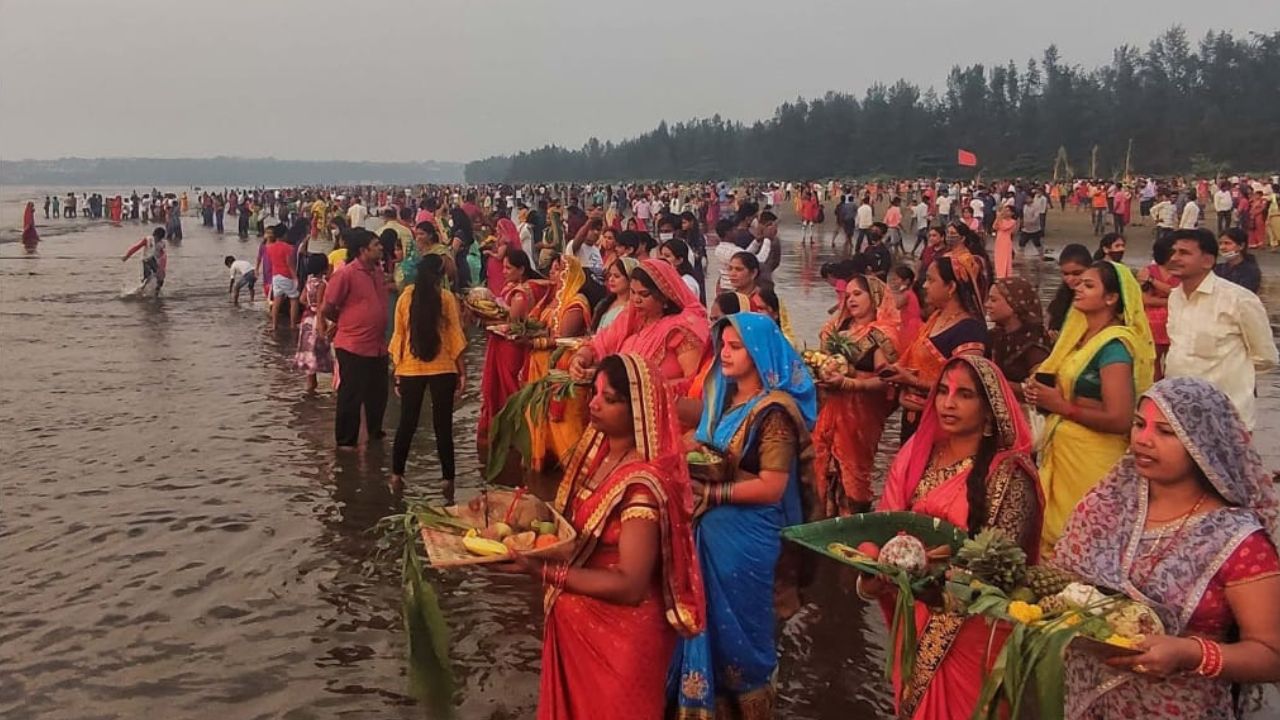
PANAJI
As the sun begins to set on Monday and rises on Tuesday, Goa’s beaches from Miramar to Vasco and Colva will shimmer not just with the glow of the sun, but with the radiance of devotion.
Draped in vibrant sarees and vermilion from the bridge of their nose to the parting of their hair, hundreds of women will stand waist-deep in water with offerings for nature, eyes closed, palms folded, and hearts lifted in prayer to the Sun -- both setting and rising.
This is Chhath Puja -- the ancient Vedic festival of gratitude to Surya, the Sun God -- now as much a part of Goa’s cultural landscape as its sea breeze and sand.
The most awaited festival of Bihar and Jharkhand, Chhath Puja, has long transcended its regional roots. For millions, it is an emotion, more than a celebration. As Biharis fondly say, it is the most awaited festival after Diwali. Across India and abroad, wherever the community has made its home, this four-day ‘Mahaparv’ is recreated with the same devotion and precision as in the heartlands of the Ganga.
Goa, too, joins this growing map of devotion. From the banks of Ponda’s rivulets to the shores of Miramar, the rituals unfold with striking authenticity.
The festival, this year, has already begun with Nahaye Khaye on Saturday, marking the ceremonial start when devotees take a holy dip and partake of a single, pure meal before beginning their 36-hour nirjala fast. Today, Sunday, is 'Kharna' when the vrati (fasting women) observe rigorous rituals, culminating in Sandhya Arghya (evening offerings) and Usha Arghya (morning offerings) — during which the Sun, both setting and rising, is worshipped for sustaining life on earth.
“During the Chhath Puja, the devotees, especially women, worship the Sun in a four-day ritual. In our family, the senior-most female member performs the ritual of Chhath Puja, and my mother will be performing it in our village, Samastipur, in Bihar. Since I have an elder brother, his wife will shoulder the responsibility after my mother,” stated Saroj Kumar Chaudhari, the current president of Chhath Puja Seva Samiti.
Chaudhari has been living in Goa since 1993 and his family shifted here in 2001. Likewise, there are around 10,000 families, all natives of Bihar settled across Goa.
The credit of initiating the celebration of Chhath Puja in Goa goes to Siddheshwar Nath Mishra, popularly known as S N Mishra, the current secretary of the Chhath Puja Seva Samiti at Ponda.
Founded on October 20, 2013, the Samiti began as a small socio-cultural initiative to unite communities and celebrate the festival’s spiritual essence. “In those days, only two families celebrated Chhath near the Mahadev Mandir at Curti Ponda,” Mishra recalls. “With every passing year, the numbers grew.”
The turning point came in 2014 when the late Dr Mridula Sinha, then Governor of Goa and a native of Bihar, attended the celebration and sang the Chhath songs originally sung by Bihar’s famous Kokila - late Sharda Sinha. Since then, the Samiti has never looked back. “Last year around 4,000 people participated, and this year the number is expected to be over 5,000,” Mishra said.
From 12 families in 2012 to thousands now, the transformation mirrors the journey of migration and belonging. Around 200 to 250 women perform the arduous 36-hour fast each year at the riverbank in Ponda. Men, though fewer in number, also join the rituals.
This year, the Chhath Puja ritual will begin an hour before sunset on October 27 at around 5.15 pm and continue till 7 pm. On October 28, the ritual will start one hour before sunrise, at around 5 am and continue till 8 am.
Across Goa at various places – Miramar beach in Panaji, Baina Beach at Vasco and Colva Beach –hundreds of women will throng to participate in the Chhath Puja. Thousands of men and women will attend to witness it.
Indeed, Chhath Puja is no longer confined to Bihar’s ghats, Jharkhand eastern UP, and the Madesh region of Nepal. It is now celebrated in places as far apart as Mauritius, Fiji, Trinidad and Tobago, Guyana, Suriname, and Jamaica — carried by the diaspora who took their traditions wherever they went.
“Wherever the Bihari community is settled, be it anywhere in India or abroad, this ritual is followed on the sixth day of the Kartik month. We started it in Goa because every year, the people from our community would travel to Bihar to celebrate the festival, and there would be issues with the non-availability of tickets. To avoid this, we took initiative and now people, instead of travelling to their native place, gather at various places in Goa to celebrate the festival,” stated Mishra who is happy that people from Porvorim, Sankhali, Bicholim and Margao travel to Ponda to participate or witness the celebration.
Chhath Puja, as Mishra says, “is a people’s festival. It is a Vedic traditional ritual of thanksgiving to the Sun, and this has been carried forward by our community with great faith and passed on to the next generation.” As women sing folk hymns and offer thekua (a sweet made of wheat flour and jaggery), the air will be filled with chants that have echoed through centuries across the plains of North India.